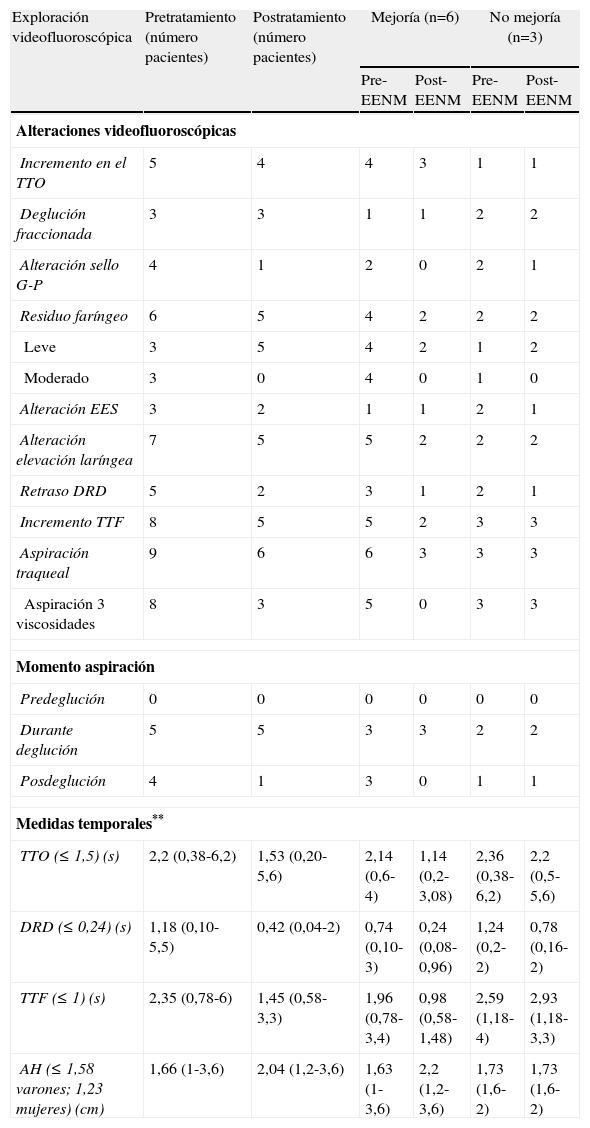La disfagia orofaríngea es muy prevalente en pacientes con ictus, con una elevada morbimortalidad asociada. La electroestimulación neuromuscular (EENM) es un nuevo tratamiento potencialmente útil. El objetivo de este estudio fue valorar la eficacia terapéutica y la seguridad de la EENM en el tratamiento de la disfagia orofaríngea en pacientes con ictus.
Pacientes y métodoEstudio prospectivo de 9 pacientes con ictus, con aspiración traqueal confirmada mediante exploración videofluoroscópica (VDF), tratados con el tratamiento convencional de la disfagia orofaríngea junto con EENM. Se realizó seguimiento al finalizar el tratamiento con EENM y a los 3 meses.
ResultadosEl número medio de sesiones efectuadas fueron 18 (intervalo 15-20), con una intensidad media de estimulación de 12,45mA (intervalo 6,6-16,7mA). Antes del tratamiento 8 pacientes se alimentaban exclusivamente por sonda de gastrostomía; tras el mismo únicamente un paciente persistía con alimentación exclusiva por sonda de gastrostomía. Ningún paciente presentó complicaciones. Los parámetros VDF previos al tratamiento, tiempo de tránsito oral, disparo del reflejo deglutorio (DRD) y tiempo de tránsito faríngeo, estaban alargados y el ascenso hioideo reducido. Después del tratamiento se redujo a 6 el número de pacientes con aspiración traqueal, pero únicamente en 3 persistía para las 3 viscosidades estudiadas (líquido, néctar y pudin), objetivándose una mejoría global en los parámetros VDF. El único factor predictivo de efectividad terapéutica fue el retraso en el DRD.
ConclusiónLa EENM ha mostrado ser un tratamiento eficaz y seguro en los pacientes con disfagia orofaríngea secundaria a ictus.
Oropharyngeal dysphagia is highly prevalent in stroke patients, with a high mortality and morbidity. Neuromuscular electrostimulation (NMES) is a new and potentially useful therapy. We assessed the therapeutic effectiveness and safety of NMES in the treatment of oropharyngeal dysphagia in patients with stroke.
Patients and methodProspective study of stroke patients, with tracheal aspiration revealed by videofluoroscopy (VDF), who underwent conventional therapy of oropharyngeal dysphagia as well as NMES. We did a follow-up at the end of the treatment and 3 months later.
ResultsPatients underwent 18 courses of treatment (15-20) with a mean stimulation intensity of 12.45mA (range: 6.6-16.7mA). Before starting therapy, 8 patients were fed exclusively by means of a gastrostomy tube; after the treatment, only one patient needed it. No patient had complications. VDF parameters before treatment: oral transition time, swallowing reflex shooting (SRS) and pharyngeal transition time were longer and the hyoid elevation was reduced. After the treatment, the number of patients with tracheal aspiration decreased to 6, but only in 6 it persisted for the three analyzed viscosities (liquid, nectar and pudding), with an overall improvement of the VDF parameters. The only predictive factor of therapeutic effectiveness was the delay in the SRS.
ConclusionNMES is an effective and safe treatment for stroke patients with oropharyngeal dysphagia.
Artículo
Comprando el artículo el PDF del mismo podrá ser descargado
Precio 19,34 €
Comprar ahora








